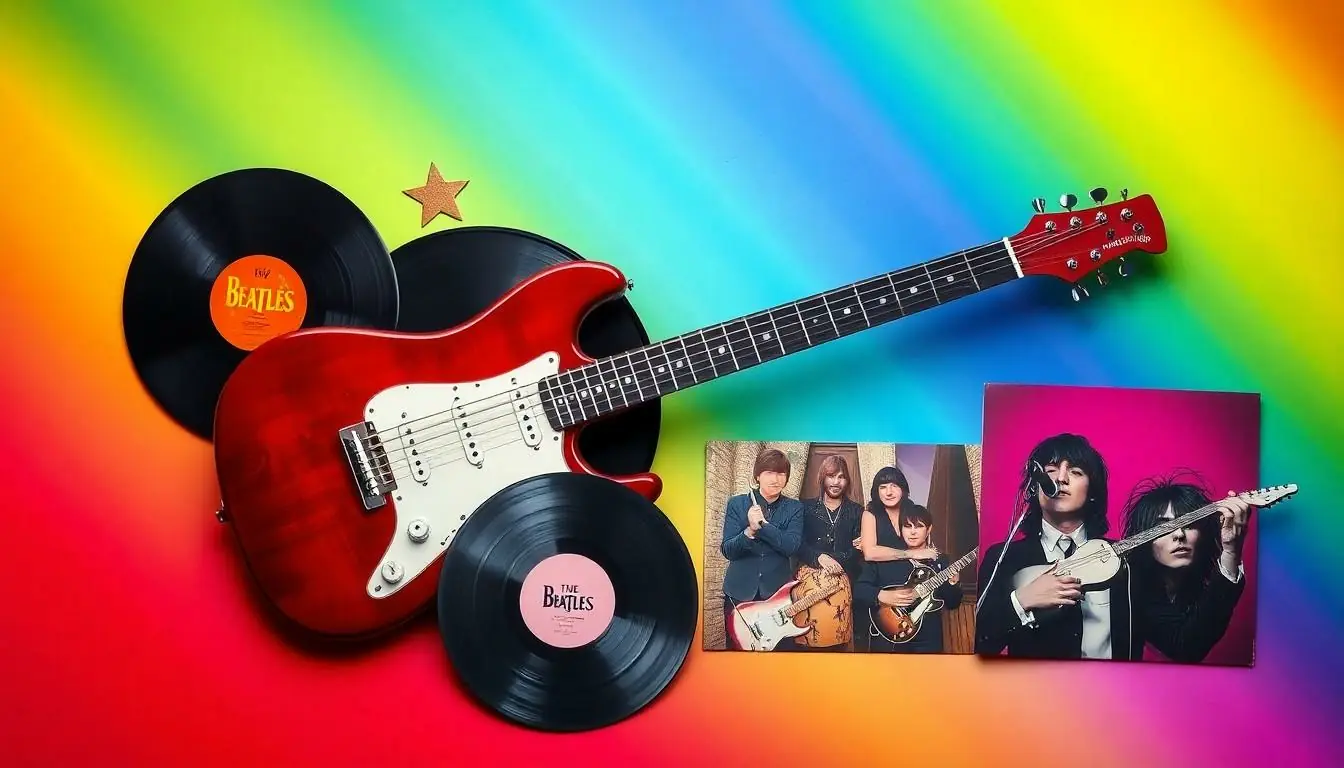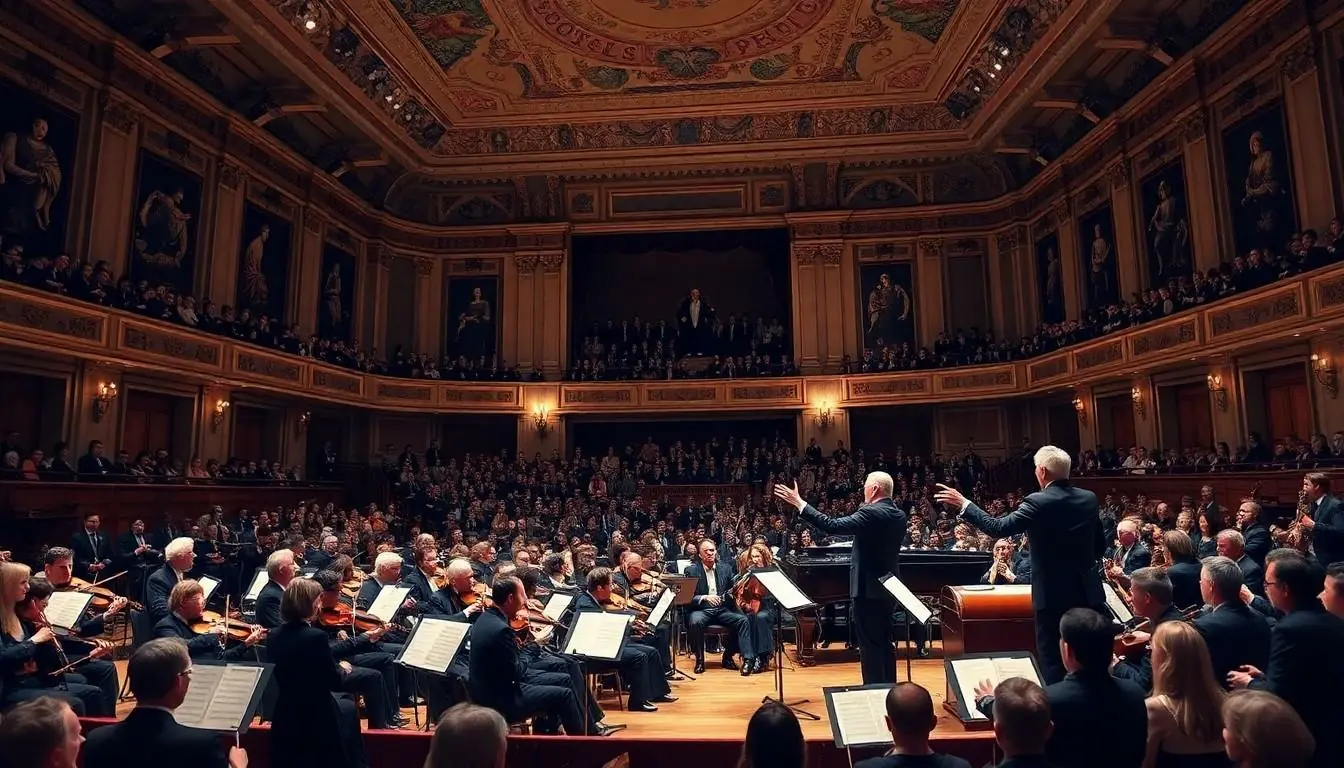Pop rock music is the irresistible blend of catchy melodies and electrifying guitar riffs that makes it impossible to resist tapping your feet. With its roots in the classic rock era, this genre has evolved into a vibrant sound that appeals to listeners of all ages. Picture yourself driving down the highway with the windows down, your favorite pop rock anthem blasting through the speakers—pure bliss, right?
From chart-topping hits to underground gems, pop rock captures the essence of youthful energy and relatable lyrics. It’s the soundtrack to countless moments, whether you’re belting out tunes in the shower or bonding with friends over shared playlists. Dive into the world of pop rock, where every song tells a story and every beat invites you to sing along. Get ready to explore why this genre continues to dominate the airwaves and capture hearts worldwide.
Table of Contents
ToggleOverview of Pop Rock Music
Pop rock music blends elements of pop and rock, creating an accessible sound that resonates with a diverse audience. This genre features catchy melodies and engaging guitar riffs, appealing to listeners across various age groups. Influenced by classic rock, pop rock has evolved significantly since its inception, incorporating contemporary production techniques and styles.
Notable pop rock artists include bands and solo musicians who infuse their work with youthful energy and relatable lyrics. Lyrics in pop rock often explore themes of love, friendship, and personal growth, making them resonant with many. The genre’s ability to connect with listeners on an emotional level contributes significantly to its popularity.
Throughout the decades, pop rock has offered numerous chart-topping hits. For instance, songs by artists such as Maroon 5, Paramore, and Katy Perry showcase the genre’s ability to adapt while maintaining its core characteristics. This evolution reflects broader musical trends and cultural shifts.
Moreover, pop rock frequently intersects with other genres, enhancing its appeal. Collaborations with electronic, hip-hop, and indie artists further diversify the sound and broaden its reach. Consequently, pop rock remains a staple in popular music, frequently appearing in movies, television shows, and commercials.
Overall, pop rock’s enduring presence in the music industry highlights its significance. Engaging melodies and strong lyrical connections ensure that this genre continues captivating audiences, serving as a soundtrack for life’s notable moments.
Historical Background

Pop rock music originated from the fusion of pop and rock genres in the mid-1960s. This blending produced a sound that appealed to a broader demographic, gaining traction among varied age groups.
Origins of Pop Rock
The roots of pop rock trace back to the British Invasion, with bands like The Beatles and The Rolling Stones pioneering the style. Their catchy melodies and relatable lyrics set the stage for future pop rock artists. American musicians embraced this trend, combining rock’s raw energy with pop’s accessibility. This collaboration encouraged a new wave of artists to experiment with the genre, cultivating its identity.
Evolution through the Decades
Throughout the 1970s, pop rock evolved significantly, integrating elements from funk, disco, and punk. Artists like Elton John and Fleetwood Mac exemplified this evolution, charting numerous hits. The 1980s further transformed pop rock with the rise of synthesizers and music videos, epitomized by acts like Duran Duran and Madonna, who enhanced the genre’s visual appeal. The 1990s brought a mix of grunge and alternative influences, with bands like third-eye blind and Matchbox Twenty carving their place in pop rock history. In the 2000s, pop rock diversified again, with artists like Tegan and Sara demonstrating its versatility and appeal across generations.
Key Characteristics of Pop Rock Music
Pop rock music features vibrant melodies and relatable themes, appealing to a broad audience. Key characteristics help define its sound and style.
Melodic Elements
Catchy hooks define pop rock tracks, emphasizing singable melodies that resonate with listeners. Often characterized by verse-chorus structure, these songs maintain a balance between simplicity and depth. Harmonies play a crucial role, creating a rich, layered auditory experience. Repetition stands out in memorable choruses, encouraging audience engagement. Many artists utilize vocal techniques that convey emotion, enhancing the overall connection to the lyrics.
Instrumentation Style
Instrumentation in pop rock blends traditional rock elements with pop influences. Electric guitars produce energetic riffs that drive the rhythm, while synthesizers add layers of sound. Bass lines often provide groove, anchoring the melody and enhancing the track’s vibrancy. Drums deliver infectious beats that encourage movement and participation. In addition, studio production techniques elevate the overall sound, refining tracks for radio play. This versatility invites collaborations across genres, making pop rock uniquely adaptable.
Notable Pop Rock Artists and Bands
Pop rock’s landscape features a blend of established stars and fresh talent, each contributing to the genre’s dynamism.
Iconic Figures in the Genre
Maroon 5 stands out with chart-topping hits like “Sugar” and “Girls Like You,” showcasing their knack for catchy melodies. Paramore’s evolution through albums like “Riot!” solidified them as a staple, with anthems such as “Misery Business” capturing youthful angst. Katy Perry, known for her vibrant sound and powerful lyrics, has delivered pop rock classics like “Teenage Dream.” Other influential figures include Kelly Clarkson, whose powerful vocals on tracks like “Since U Been Gone” blend rock energy with pop sensibilities. These artists exemplify the genre’s ability to fuse catchy hooks with relatable themes, creating timeless music.
Emerging Talents
Today’s pop rock scene is enriched by emerging talents, who are reshaping the genre. Artists like Tegan and Sara are known for their unique sound, blending indie elements with pop rock’s catchy structures. Young musicians such as Olivia Rodrigo, with her viral hit “drivers license,” exemplify emotional lyrics paired with infectious melodies. YUNGBLUD combines punk influences with pop rock, attracting a broad audience with tracks like “Parents.” Additionally, artists like Conan Gray bring fresh perspectives to the genre, blending storytelling with contemporary pop rock styles. These new talents ensure that pop rock continues to evolve while maintaining its core appeal.
Cultural Impact of Pop Rock Music
Pop rock music significantly shapes cultural landscapes, influencing fashion, language, and lifestyles. This genre resonates across generations, creating a shared experience among diverse groups.
Influence on Popular Culture
Pop rock music often drives trends in fashion and lifestyle choices. Artists frequently set styles that fans adopt, turning concert outfits into statements of identity. Music videos contribute to this influence, showcasing iconic looks and memorable dance moves. Presenting relatable narratives, pop rock songs connect with listeners, embedding phrases and idioms into everyday conversation. These connections promote a sense of belonging, generating lasting cultural impressions that extend beyond music.
Role in Social Movements
Pop rock music plays a crucial role in addressing social issues, providing a platform for advocacy. Many artists use their popularity to raise awareness about topics like mental health, climate change, and equality. Songs often ignite conversations, inspiring action and solidarity among listeners. Collaborative efforts among musicians further amplify messages, uniting fans around shared causes. Pop rock not only entertains but also instigates meaningful dialogue, positioning itself at the forefront of social change.
Pop rock music remains a powerful force in the music industry. Its unique blend of catchy melodies and relatable lyrics ensures it resonates with listeners across generations. The genre’s ability to adapt and evolve while maintaining its core characteristics speaks to its enduring appeal.
Emerging artists continue to infuse fresh perspectives into pop rock, ensuring its relevance in today’s musical landscape. As it intersects with various genres, pop rock not only entertains but also fosters community and sparks important conversations. This vibrant genre will undoubtedly continue to shape cultural narratives and inspire future generations.




